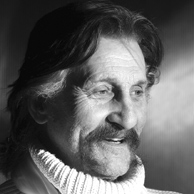
Argomenti affini:
Luigi Colani
designer - artist (1928 - 2019)
Luigi Colani is considered, as well as an industrial designer, also a "scientist - artist" given the vastness and originality of his projects and research, often visionary, precursors of innovative developments.
Colani was born in Berlin in 1928 to his father, a film architect of Swiss origin, and his mother, of Polish origin, employed by a theater company. His birth name was Lutz which later changed to Luigi.
Since the family was very large with many children, it was not possible to give many gifts to everyone, the parents educated them to build their own toys. This teaching was developed by little Lutz who in a few years was able to build objects using various materials, such as wood, iron, plaster or clay.
His favorite toys are means of transport, for which little Colani used to build models of planes, cars or ships.
In 1946, Lutz Colani enrolled at the Academy of Fine Arts in Berlin, where he attended sculpture and painting courses. Two years later he enrolled at the Sorbonne in Paris, where he studied aerodynamics.
At the beginning of 1953 he moved to California, to the aeronautical manufacturer Douglas Aircraft Company, where he participated in research on new materials, already as manager.
At the end of the same year, Lutz Colani returned to France, where he began to deal with automotive design, in particular the aerodynamics of a car body. In 1954, in Geneva, he received the Golden Rose award for his work in the field of automotive aerodynamics.
During the fifties he developed his creative language, made of curves and roundness that evoke the dynamism and vitality of the object. Colani has always proclaimed himself a supporter of rounded lines. This stylistic trend, which Colani makes his own, is known as "bio-design".
In 1957 Colani changed his name from Lutz to Luigi. In the same year he created a car based on the Alfa Romeo Giulietta, later called Colani Alfa Romeo. The sporty car is the first to complete the lap of the Nürburgring circuit in less than 10 minutes.
In 1959, Luigi Colani created a work based on the newborn BMW 700.
The following decade saw Colani dedicated to automotive design, but also to include other sectors of design and commonly used objects, such as home furniture, in his interest. In 1968, having gathered a team of designers, Luigi Colani founded his own design studio in Westphalia and began working on the potential of plastic materials for the construction of cars, furniture and equipment such as cameras.
In 1972 Colani designed the aerodynamics of a Formula 1 car, the Eifelland, based on a March chassis and driven by Rolf Stommelen. The car, modified several times during the season, did not achieve great results also due to lack of funds, but is still remembered today for its innovative design.
From this point Colani received acclaim from all over the world, even from distant Japan, where in 1973 he moved to study the possibilities offered by that country.
Back in Europe, he continues his research towards new frontiers of design, also dealing with heavy vehicles. In 1976 he created a small plane with plastic panels, powered by a Wankel engine, called Fanliner.
In 1981, he aerodynamically prepared a Citroën 2CV, managing to make it travel 100 km with only 1.7 liters of fuel, setting a record for reduced consumption.
In 1982 he returned to Japan, where he taught industrial design and where, in 1985, he created the "Colani Tokyo Robot Theatre". In 1986 he returned to Europe and founded the Colani Design Studio in Bern.
In the nineties, Colani further expanded the field of his activity: in addition to means of transport, he dealt with the design of household appliances (such as personal computers), everyday objects (such as glasses, watches and even wallpaper), more particular objects, such as some musical instruments.
One of his most ambitious projects concerns the Bio-City, a city designed by Colani following his bio-design criteria.
Even the first years of the new century saw Colani, now in advanced age but always active and volcanic, dedicating himself to the study of new objects such as microscopes, showers, airplanes and trucks.
After his first recognition in 1954 he received numerous other prizes and recognitions which consecrated Luigi (Lutz) Colani in the Olympus of international industrial design.






